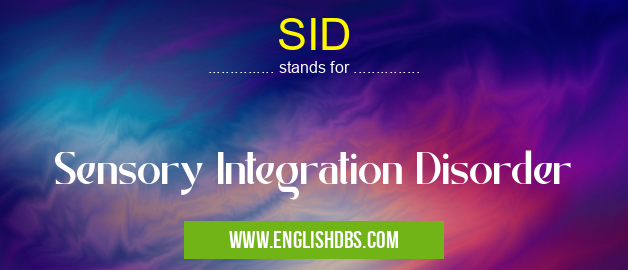What does SID mean in UNCLASSIFIED
SID is one of the frequently used abbreviations in many fields of knowledge and disciplines. It stands for Sensory Integration Disorder, which is a neurological disorder that affects how a person's brain processes and interprets information from the various senses – auditory, tactile, olfactory, visual and vestibular. This medical condition can lead to difficulties with motor skills, balance, self-regulation and behavior. It can also lead to challenges in learning and performing daily tasks. In this article we will look closer at what SID means and what other implications it has.

SID meaning in Unclassified in Miscellaneous
SID mostly used in an acronym Unclassified in Category Miscellaneous that means Sensory Integration Disorder
Shorthand: SID,
Full Form: Sensory Integration Disorder
For more information of "Sensory Integration Disorder", see the section below.
Essential Questions and Answers on Sensory Integration Disorder in "MISCELLANEOUS»UNFILED"
What is Sensory Integration Disorder?
Sensory Integration Disorder (SID) is a neurological disorder that affects the way the brain interprets and processes sensory information. This can result in difficulties with self-care, communication, daily activities, and/or being able to interact in an age-appropriate manner.
What are some common signs of SID?
Common signs of SID include difficulty paying attention and focusing, over-sensitivity or under-sensitivity to different senses such as sound or touch, hypersensitivity to certain textures or odors, frequent tantrums or meltdowns, difficulty calming down after becoming aroused or excited.
How is SID diagnosed?
Diagnosis of SID typically requires an evaluation by an occupational therapist who specializes in sensory processing disorders. Through a detailed history and physical examination as well as standardized testing they can diagnose whether someone has a sensory processing disorder.
How can SID be treated?
Treatment for SID usually includes a combination of therapies such as occupational therapy, physical therapy, speech therapy, and/or behavioral modification therapies. In addition, medications may be prescribed when necessary.
Does having Autism Spectrum Disorder mean I have SID?
Not necessarily. While some people with Autism Spectrum disorder have been found to also have symptoms of Sensory Integration Disorder, it is not the case for everyone on the spectrum. A diagnosis would need to be made by an experienced professional specializing in the condition before any conclusions can be made.
Can adults have Sensory Integration Disorder?
Yes! Adults can experience symptoms related to Sensory Integration Disorder just like children do. It can manifest differently in adulthood so it might look different than how it does in children but there are treatments available that could be very helpful!
Is medication always necessary for treatment of SID?
No! Medication is not always needed for treatment of SID and many people find success without medicating at all. Depending on each person's individual situation however medication may become necessary along with other forms of therapy.
Are there lifestyle changes I can make that could help with my child's SID symptoms?
Absolutely! It is important to provide a consistent routine for your child with lots of structure so that they know what to expect each day. Creating an environment that’s conducive to relaxation by avoiding too much stimulation and noise can also help reduce their anxiety levels. Additionally providing them with tools such as weighted blankets or noise cancelling headphones might help them feel more comfortable.
Final Words:
Sensory Integration Disorder (SID) is a neurological disorder that affects how a person's brain processes sensory information from the various senses – auditory, tactile, olfactory, visual and vestibular – leading to difficulties with motor skills, coordination and self-regulation among other things. Symptoms include hypersensitivity to noise or smell; under or overreacting to touch; challenges focusing on activities; difficulty transitioning between activities etc., though these vary from person to person depending on the amount of disruption caused by the condition’s symptoms. Treatment involves occupational therapy which helps people learn adaptive techniques for dealing with their sensations issues alongside other therapies tailored to specific individuals needs so they can function independently within different life situations.
SID also stands for: |
|
| All stands for SID |
